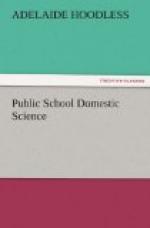LAMB.
Lamb, when tender and of the right age, is quite as digestible as beef or mutton, but the flesh contains too large a proportion of fat.
[Illustration: FIG. 1.—Diagram of cuts of beef.]
[Illustration: FIG. 2.—Diagram of cuts of veal.]
[Illustration: FIG. 3.—Diagram of cuts of pork.]
[Illustration: FIG. 4.—Diagram of cuts of mutton.]
VENISON.
Venison is a tender meat with short fibres, which is very digestible when obtained from young deer, but is considered to be rather too stimulating. Its chemical composition is similar to lean beef.
PORK.
Pork is a tender-fibred meat, but is very indigestible owing to the high percentage of fat, which is considerably more than the nitrogenous material it contains. Pork ribs may have as much as 42 per cent. of fat.
HAM AND BACON.
Ham is more digestible when well boiled and eaten cold. Bacon is more easily digested than either ham or pork; when cut thin and cooked quickly—until transparent and crisp—it can often be eaten by dyspeptics, and forms an excellent food for consumptives.
FOWL.
Chicken is one of the most digestible of meats, contains considerable phosphorus and is particularly valuable as food for invalids. Turkey is somewhat less digestible than chicken. Ducks and geese are difficult of digestion, unless quite young, on account of the fat they contain.
GAME.
Game, if well cooked, is fairly digestible.
SWEETBREAD.
Sweetbread, which is thymus gland of the calf, is a delicate and agreeable article of diet, particularly for invalids. Tripe, heart, liver and kidneys are other forms of animal viscera used as food—valuable chiefly as affording variety.
FISH.
The chief difference in fish is the coarseness of fibre and the quantity of fat present. Fish which are highly flavored and fat, while they may be nutritious, are much less easy of digestion than flounder, sole, whitefish, and the lighter varieties. The following fish contain the largest percentage of albuminoids:—Red snapper, whitefish, brook trout, salmon, bluefish, shad, eels, mackerel, halibut, haddock, lake trout, bass, cod and flounder. The old theory that fish constituted “brain food,” on account of the phosphorus it contained, has proved to be entirely without foundation, as in reality many fish contain less of this element than meat. The tribes which live largely on fish are not noted for intellectuality. Fish having white meat when broiled or boiled—not fried—are excellent food for invalids or people of weak digestion. Fish should be well cooked.
OYSTERS.
Oysters are a nutritious food, and may be eaten either raw or cooked. Lobsters, crabs and shrimps are called “sea scavengers,” and unless absolutely fresh are not a desirable food.
MILK.




